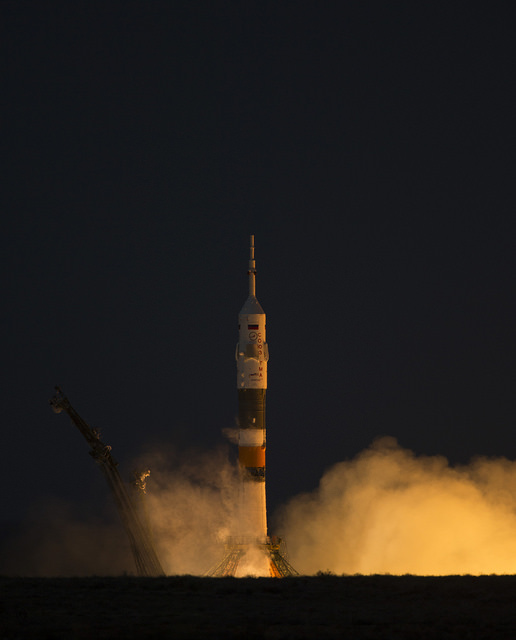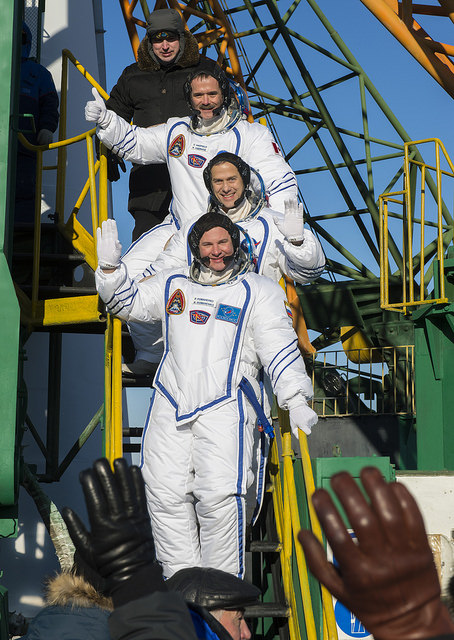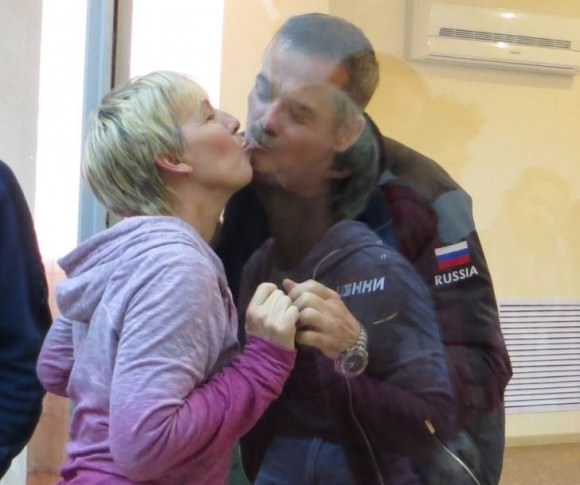The Soyuz TMA-07M rocket launches from the Baikonur Cosmodrome in Kazakhstan on Wednesday, Dec. 19, 2012 carrying the Expedition 34 crew to the International Space Station. Credit: NASA/Carla Cioffi
Heading off just as the Sun was setting amid frigid conditions at the Baikonur Cosmodrome in Kazakhstan, a trio of international explorers launched to space, on their way to the International Space Station. Chris Hadfield of the Canadian Space Agency, Tom Marshburn of NASA, Roman Romanenko of the Russian Federal Space Agency (Roscosmos) launched Wednesday at 12:12 UTC (7:12 a.m. EST, 6:12 p.m. Baikonur time). Their Soyuz TMA-07M performed flawlessly, and the crew is expected to dock with the Rassvet module on the Russian segment of the space station at 14:12 UTC (9:12 a.m. EST) on Friday, Dec. 21.
See the launch video below:
Temperatures were below freezing, with a windchill reported of -34 C at launch time. But as Hadfield told Universe Today, the Soyuz rocket is just as robust and one of the most reliable rockets ever. “The Soyuz launches all-weather, -40 degrees to +40 degrees,” Hadfield said. “It is rugged, built on experience, and it is not delicate. I trust it with my life.”
Hadfield, Marshburn and Romanenko will join their Expedition 34 crewmates already on board the ISS — Commander Kevin Ford and Flight Engineers Oleg Novitskiy and Evgeny Tarelkin — to bring the crew back to the standard size of six.
Two minutes into flight, the Soyuz rocket’s four liquid-fueled first stage boosters were jettisoned. Via NASA TV.
Hadfield will make history on March 15, 2013 as he will become the first Canadian astronaut to take command of the ISS.
The focus of Expedition 34/35 is scientific research, with the astronauts serving as subjects for human physiology tests, including examinations of astronaut bone loss.
While not officially decided yet, Hadfield indicated a spacewalk may be in order for him and one of his ISS crewmates to perform some needed maintenance outside the space station.
Expedition 34 NASA Flight Engineer Chris Hadfield of the Canadian Space Agency (CSA), top, NASA Flight Engineer Tom Marshburn and Soyuz Commander Roman Romanenko wave farewell from the bottom of the Soyuz rocket. Credit: (NASA/Carla Cioffi)
During their stay, the crew will be busy welcoming both a Russian Progress and ESA’s ATV cargo ships, as well as two commercial resupply missions from SpaceX and the first flight of Orbital Science’s Cygnus spacecraft.
The crew also will also be conducting a wide range of physical science, Earth observation, human research and technology demonstration investigations. Experiments will investigate how fire behaves in space, which could help improve engine fuel efficiency and fire suppression methods in space and on Earth. Other research will look at fluids that change physical properties in the presence of a magnet, which could improve bridge and building designs to better withstand earthquakes. With the help of cameras set up by the crew, students on Earth are capturing photos of our planet.
For a look at the training done by Chris Hadfield in preparation for his flight, see our series “How to Train for Long Duration Space Flight.”
“One last kiss before I go – love under glass with my wife. It’s launch morning, I slept well, feel great,” Hadfield Tweeted this morning before launch.





Great news about a succesful launch! Best of wishes to the whole crew! And I really liked the kiss photo. It’s a very touching, personal moment.
Every launch is an amazing and important event. If countries are exploring and learning together, they aren’t trying to kill each other.